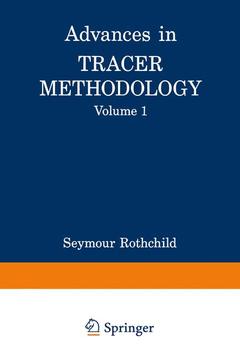Advances in Tracer Methodology, 1963 Volume 1
Langue : Anglais
Auteur : Rothchild Seymour

The five Symposia on Advances in Tracer Methodology were held annually from 1957 to 1961. The symposia were directed to scientists who are active in utilizing tracer techniques to help solve their scientific problems. The format, an informal one-day meeting consisting of about ten papers and closing with a cocktail hour, fostered an active exchange of information among speakers and audience. Although the first two symposia were restricted to the use of tritium as a tracer isotope, the larger purpose of the meetings was to disseminate information relating to the entire isotopic tracer field. The sponsoring organizations, all actively engaged in selling products in the nuclear field, attempted to provide a noncom mercialized forum which would facilitate this exchange of in formation. The collection of papers presented herein represents most of the talks presented at the first symposia plus several appropriate papers which have appeared either in Atomlight, the bulletin of the New England Nuclear Corp., or which have been submitted directly for inclusion in this collection. Although each of the authors was given the opportunity to revise his paper, it is likely that some of the techniques or instrumentation described may already have been outmoded by recent improvements.
Opening Remarks by Chairman (1957 Symposium).- The Tritium Gas Exposure Method.- The Gas Exposure Technique for Tritium Labeling.- Experiences with Tritiated Compounds Prepared by Exposure to Tritium Gas.- Reaction of Unsaturated Organic Compounds with Tritium Gas.- Tritium Gas Exposure Labeling.- Some Experiences with Labeling Sugars by Tritium Gas Exposure.- Some Experiences with Labeling Nucleotides.- Correlation of Efficiency of Labeling with Chemical Constitution.- The Radiation-Induced Addition of Tritium to Unsaturated Systems.- Tritium Labeling by Other Methods.- Tritium Labeling by Other Methods.- Tritium Recoil Labeling of Linseed Oil.- Preparation of Tritium-Labeled Paromomycin (Humatin) by Fermentation in a Medium Containing Tritiated Water.- Some Aspects of Stereoselectivity in the Introduction of Tritium into Steroids.- Radiation Decomposition.- Radiation Self-Decomposition of Labeled Compounds.- Liquid Scintillation Counting.- Liquid Scintillation Counting of Tritium.- Recent Developments in Simultaneous C14 and Tritium Counting.- Determination of Liquid Scintillation Counting Efficiency by Pulse-Height Shift.- A New Technique for Counting Aqueous Solutions in the Liquid Scintillation Spectrometer.- Liquid Scintillation Counting of Tritium in Suspended Materials.- Counting C14O2 with a Liquid Scintillation Counter.- Liquid Scintillation Counting of C14O2 in Aqueous Carbonate Solutions.- Determination of Radioactive Sulfur in Biological Materials.- Scintillation Counting of C14-Labeled Paper Chromatograms.- Simultaneous Measurement of C14 and H3 during Gas-Liquid Chromatography.- Monitoring Gas Chromatography for H3- and C14-Labeled Compounds by Liquid Scintillation Counting.- Application of Whole-Body Liquid Scintillation Counters to Pharmacological Studies.- A Comparison of Ionization-Chamber and Liquid Scintillation Methods for Measurement of Beta Emitters.- Gas Counting.- Tritium Measurement Using Ionization Chambers.- Gas Counting of Tritium.- Vapor Phase Proportional Counting.- Combustion Methods.- Determination of Tritium and C14 in Biological Samples by Rapid Combustion Techniques.- Parr Bomb Combustion of Tissues for C14 and Tritium Analysis.- Instrumentation.- Recent Advances in Instrumentation.- Health Physics.- Tritium Health Physics Considerations.- Measuring Turnover Rates.- Design and Analysis of Tracer Experiments.- Design and Analysis of Tracer Experiments—Biochemical Aspects.- Experimental Design of Turnover Measurement Studies in the Unsteady State: Biosynthesis of Macromolecules.- Measuring Turnover Rates in the Nonsteady State.- Tritium as a Tracer Isotope.- Tritium in Biochemical Studies.- Special Features of Tritium as a Tracer in Industrial Research.- Some Uses of Tritium-Labeled Compounds in Pharmaceutical Research.- Metabolism of DL-Epinephrine-7-H3 D-Bitartrate.- Application of Tritium in the Determination of Gibberellins.- New Developments in the Use of Radioisotopes in Reservoir Engineering.- Tracer Methodology.- Use of Radioisotopes in Steroid Methodology.- Metabolism Studies by Radiorespirometry.- Autoradiography.- Auto radiography with Tritium.- Some Uses of Tritium in Autoradiography.- The Efficiency of Autoradiography Stripping-Film Applied to Tissue Sections Containing Tritiated Thymidine.- Autoradiography of Whole Animals as an Experimental Tool in Pharmacological Research.- Clinical Methodology.- Clinical Use of the Arm Counter in Blood Clearance Studies.
Date de parution : 05-2012
Ouvrage de 332 p.
15.2x22.9 cm
Thème d’Advances in Tracer Methodology :
Mots-clés :
© 2024 LAVOISIER S.A.S.



